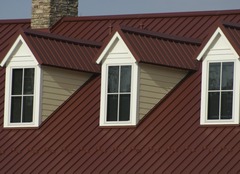As a result of the last-minute enactment of the Taxpayer Relief Act earlier this year, six common energy-efficient upgrades you may have made to your home in 2012 or plan to make this year are eligible for a federal tax credit. Replacement windows and doors, new roofs and upgrades to heating and ventilation systems all qualify for a credit of up to $500. The improvements must be made to your existing home and principal residence, new homes do not qualify. Here are the details, according to Energy Star.

Windows, doors and skylights
If you replaced any windows, doors or skylights or installed new ones that meet Energy Star standards, you are eligible for a tax credit. You don't have to replace all your windows and doors to qualify and you can claim the credit if you installed a window or door where there wasn't one before.
Tax credit: 10 percent of the cost, up to $500, but windows are capped at $200. Does not include installation.
From our experts: Window Ratings and recommendations.
From our experts: Entry door Ratings and recommendations.
Roofs (metal and asphalt)
Roofing materials that meet Energy Star requirements reflect more of the sun's rays and can lower roof surface temperature by up to 100 degrees F. Qualifying roofing materials include metal roofs with appropriate pigmented coatings and asphalt roofs with appropriate cooling granules.
Tax credit: 10 percent of the cost, not including installation, up to $500.
From our experts: Roofing Ratings and recommendations.
Insulation
Typical bulk insulation products can qualify for a tax credit, such as batts, rolls, blow-in fibers, rigid boards, expanding spray, and pour-in-place, according to Energy Star. Products that air seal (reduce air leaks) can also qualify, as long as they come with a Manufacturers Certification Statement, including weather stripping, spray foam in a can, caulk and house wrap.
Tax credit: 10 percent of the cost, up to $500. Does not include installation but you can install the insulation/home sealing yourself and get the credit.
Water heaters (non-solar)
Water heating can account for up to 25 percent of the energy used in your home. Qualifying water heaters include gas, oil or propane units with an Energy Factor (overall efficiency) of 0.82 or more or a thermal efficiency of at least 90 percent. Electric heat pump water heaters with an energy factor of 2.0 or more also qualify.
Tax credit: $300
From our experts: Water heater buying guide.
Biomass stoves
To heat a home or water, biomass stoves burn wood and wood waste and residues (including wood pellets), agricultural crops and trees, plants (including aquatic plants), grasses, residues and fibers. To qualify, stoves must have a thermal efficiency rating of at least 75 percent.
Tax credit: $300
From our experts: Pellet stove Ratings and recommendations.
Heating, ventilation and air conditioning
Some heating, ventilation and air conditioning equipment qualifies for an energy tax credit, including:
Advanced main air circulating fan. An efficient fan, or blower motor that blows the heated air from your furnace through the duct system. To qualify it must use no more than two percent of the furnace's total energy.
Tax credit: $50
Air source heat pumps. Heat pumps use electricity to move heat from a cool space into a warm, making the cool space cooler and the warm space warmer. They're an energy-efficient alternative to furnaces and air conditioners in moderate climates. Because they move heat rather than generate heat, heat pumps can provide up to four times the amount of energy they consume, says Energy Star. To qualify, the heat pumps must meet certain efficiency and performance requirements outlined on the Energy Star website.
Tax credit: $300
Central air conditioning. If you had a system installed or plan to, verify tax credit eligibility with your HVAC contractor by asking for the Manufacturer Certification Statement. Or, search the manufacturer's website. To qualify, the central air conditioning system must meet certain efficiency and performance requirements outlined on the Energy Star website.
Tax credit: $300
From our experts: Central air conditioning buying guide.
Gas, propane or oil hot water boiler. These heating units use water circulated throughout the home in a system of baseboard heating units, radiators, and/or in-floor radiant tubing. To qualify, they must have an annual fuel utilization efficiency, AFUE, of 95 percent or more.
Tax credit: $150, including installation costs.
Natural gas, propane or oil furnace. New furnaces with an AFUE of 95 percent or more qualify.
Tax credit: $150
From our experts: Gas furnace buying guide.
How to claim your tax credit
You'll need to file IRS form 5695 with your 2012 or 2013 taxes. Be sure to keep a copy of the Manufacturer's Certification Statement and any receipts or itemized bills. Tax credits for such renewable energy sources as wind, solar and geothermal will be available until the end of 2016.
